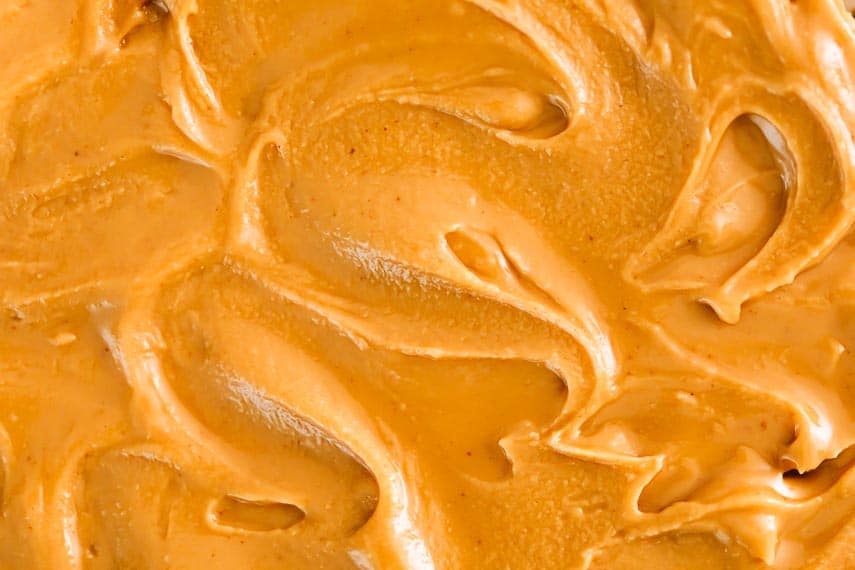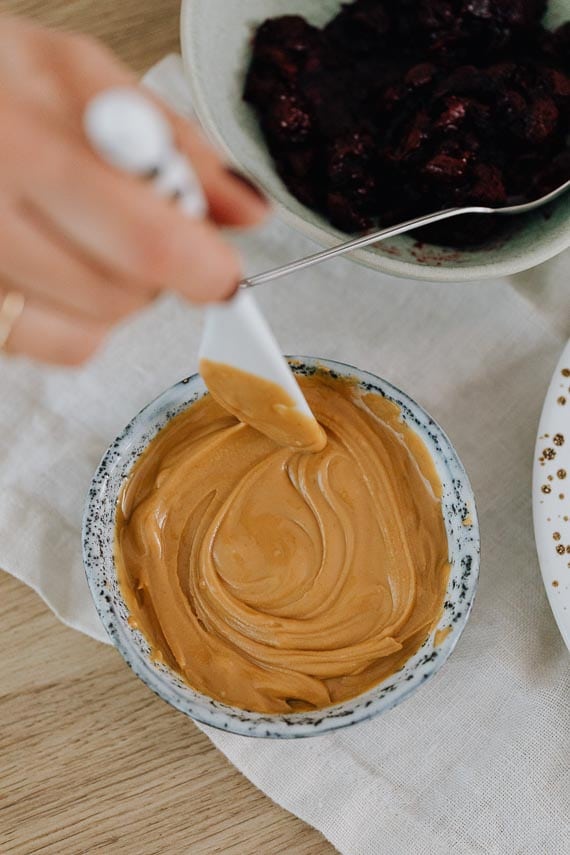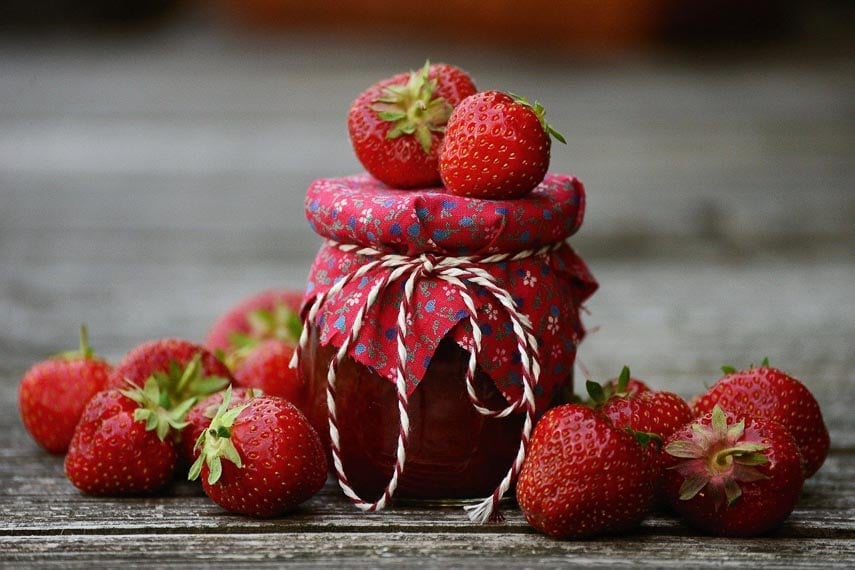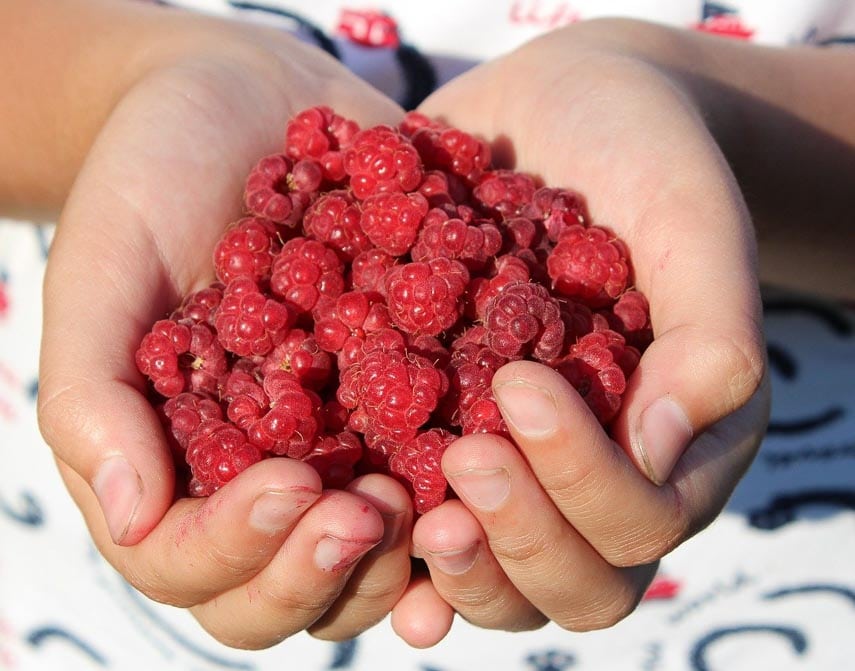Is Peanut Butter Low FODMAP? Yes, there are low FODMAP servings of peanut butter. Both Monash University and FODMAP Friendly have tested various peanut butters and this article explores the relationship between peanut butter and FODMAPs in depth.

We also explain why not all peanut butters are the same, which is important when using within recipes.
And, at the end we have thrown in some info on almond butter – and jam!
Peanut Butter & FODMAPs
Monash and FODMAP Friendly have both lab tested peanut butter. We have some information as to what kind of peanut butter was tested (unsweetened natural, made with hydrogenated oil and sugar, or no-stir style with palm oil and sugar, etc.).
Monash Info
Monash shows two entries in their smartphone app. It is not readily apparent by looking at the app what the images correspond to in terms of type or brand of peanut butter. One image shows a blue cap on the jar, which is iconic and would suggest the Skippy brand, however, it is the other listing that specifies the item is from the U.S. and that one shows a yellow cap, which is used for Peter Pan peanut butter. Monash initially would not confirm one way or another what brands were tested, but we did get eventually some information from them, and it was not a great clarification.
In private correspondence, they told us that they “collected and pooled samples from the US” and that the US peanut butter listing is a combination of the hydrogenated oil and palm oil types produced in the US. They also said that they could not find the actual products used for the generic listing, but that they were most likely very similar (i.e. not the natural type), but from a variety of producing countries rather than the US.
We find this unhelpful. No one in the US combines two kinds of peanut butter at once in sandwiches or recipes. Why they thought this was a good idea to test them this way, one can only imagine. And not having their lab notes as to what was used? SIGH.
They state that both are low FODMAP at 2 Australian tablespoons, although one is said to be 50 g (the blue cap) and the other 32 g.
Addendum: The app used to show that peanut butter became Moderate for fructose at 140 g. The current version of the app does not show this information. If you malabsorb fructose, it might be an issue.
FODMAP Friendly Info
FODMAP Friendly’s app image shows what looks to be some sort of creamy style (not a natural peanut butter). They give it a “Pass” at 2 tablespoons (50 g).

Peanuts & FODMAPs
It is also important to note that Monash has said peanuts themselves have only trace amounts of FODMAPs.
You might be interested in our article that details all of the foods that only contain a trace amount of FODMAPs.
How To Choose Peanut Butter Used In Recipes
When I am creating a recipe that focuses on peanut butter I actually think much more about texture and ingredients than flavor. Let me explain. While I can schmear any kind or brand of peanut butter on bread for a sandwich without much thought, when it comes to baking and cooking with peanut butter there is a lot more to think about.
Not all Peanut Butter Is Created Equal
Let’s take a look at types of peanut butter available in the U.S.
- “Classic” Creamy Peanut Butter: If you are following a recipe from the late 1920s through the 80s, for instance, and it calls for “peanut butter”, the product used was most likely Peter Pan, JIF or Skippy brand and was made from peanuts, sugar, hydrogenated vegetable oil and salt. The ingredients can vary slightly (JIF has molasses added; less than 2% BTW), but the ingredient to pay attention to is the hydrogenated oil. Hydrogenated oil prevents peanut butter from separating and also gives it an ultra-creamy smooth consistency. If a recipe was developed with and/or calls for this type of peanut butter, I recommend that you use it. A good substitute would be a “no-stir” style, described below, however, subbing in a natural or fresh-ground peanut butter is not recommended, and vice versa.
- “No-Stir” Style Peanut Butter “Spread”: The ingredient list for this kind of peanut butter will list peanuts, palm oil and salt, and while most also contain sugar, Skippy has an unsweetened version. Note that this item is called peanut butter “spread”. This is because palm oil is not one of the FDA’s “optional ingredients” for foods labelled “peanut butter”, hence it is a “peanut butter spread”.
- “Natural” Peanut Butter: This kind of peanut butter is not as smooth as classic peanut butter or no-stir style, and the oil can separate. It is, however, much smoother than most that is freshly ground in the store to order. I use natural peanut butter in recipe development quite a bit and when I do I recommend Smucker’s brand. It is very consistent in texture and flavor.
- Freshly Ground Peanut Butter: Some markets allow you to grind peanut butter right in the store. This is by far the coarsest (and driest) textured of all the peanut butters and it does not make a good substitute in recipes unless a recipe developer used it during development. And to be frank, I have never known a recipe developer to use this kind of peanut butter. I do not keep any in the Test Kitchen for two main reasons. First of all, the coarse and dry texture does not enhance recipes and just as importantly, there is no standardization from machine to machine, store to store.
Smooth Vs. Chunky
Any of the types of peanut butter described above, except freshly ground, can come in a smooth or chunky style. Recipes typically use smooth, but of course use whatever is called for in an individual recipe. The freshly ground peanut butter that you can make yourself in many supermarkets is somewhat gritty in texture and is usually not specified as either smooth, nor chunky.
Storing Peanut Butter
How you store your peanut butter will depend on type, length of storage, and manufacturer recommendations.
Freshly ground and natural peanut butters can go rancid more easily. If you are going to use them within a few weeks, you can store them at a cool room temperature. Longer storage is best in the refrigerator.
Peanut butters with added stabilizers, palm oil or hydrogenated oil may be stored at room temperature for more extended periods of time than natural or fresh ground, even a few months. Unopened jars can last up to 9 months in the pantry.
Always check expiration dates and defer to manufacturer recommendations.
Is Almond Butter Low FODMAP?
Monash University has lab tested almond butter and it has a lab tested low FODMAP amount of 1 Australian tablespoon at 20 g. The image shows a very smooth product and does not look like a natural style, but they will not confirm. Almond butter becomes Moderate for FODMAPs at 1 ½ Australian tablespoons or 32 g. (Their listing for almond meal, which is ground almonds, is 24 g, so these are similar results).
FODMAP Friendly has lab tested what they call “Almond Spread”. It looks like a processed product but the look of the image and not natural almond butter. It gets a “Pass” at 10 g, which is a very small amount, and they specify that GOS and fructans are present.
What is curious is that this doesn’t quite jibe with their entry for almonds, which get a “Pass” at ¼ cup or 30 g. For this amount, GOS, fructans and sorbitol are listed as present.
What Jams & Jellies Are Low FODMAP?
Yes, you can have that PB&J sandwich! As of Spring 2021 no jellies have been lab tested. They are all listed as “jams”.

Monash University has lab tested several fruity spreads:
- Strawberry Jam made with no high fructose corn syrup: Low FODMAP at 2 Australian tablespoons or 40 g.
- Strawberry Jam made with high fructose corn syrup: Low FODMAP at ½ Australian tablespoon or 10 g.
- Raspberry Jam: Low FODMAP at 2 Australian tablespoons or 40 g. Moderate for FODMAPs at 45 g.
- Marmalade: Low FODMAP at 2 Australian tablespoons or 40 g. Looks like orange marmalade, but Monash has not confirmed.
- Blueberry Jam: High FODMAP at 1 tablespoon (20 g).
- Mixed Berries Jam: Moderate for FODMAPs at 1 Australian tablespoon or 20 g; High FODMAP at 2 Australian tablespoons or 40 g. Monash has not confirmed what the blend is.
- Coconut Jam: Low FODMAP at ½ Australian tablespoon or 11 g; Moderate for FODMAPs at 1 Australian tablespoon or 23 g.

I am particularly fond of Smucker’s Natural line. You can read our full review here. I used their strawberry for the bars pictured.
Recipes Using Peanut Butter
We have many recipes – both sweet and savory – that use peanut butter:
- Garlicky Peanut Sauce
- Peanut Lime Sauce
- Low FODMAP Zoodles & Tofu
- Singapore Chicken Satay
- Asian Chicken Salad
- Peanut Butter Cheesecake
- PB&J Cheesecake Brownies
- Peanut Butter Banana Muffins
- Chocolate Peanut Butter Energy Balls
- High Protein Peanut Butter Muffins
- Chewy Peanut Butter Chocolate Chunk Cookies
- Vegan Peanut Butter Cookies
- One-Bowl Peanut Butter Cookies
- One-Bowl Low FODMAP Peanut Butter Oatmeal Chocolate Chunk Cookies with Raisins
- Chunky Rice Krispie Treats
- Low FODMAP Buckeyes
- Mocha Banana Smoothie
- Low FODMAP Peanut Butter & Jelly Bars
- And more, including a kick-ass round-up of peanutty lusciousness.
The Takeaway
You can have both peanut butter – and almond butter – even during the Elimination Phase. Stick with suggested low FODMAP serving sizes to start, remembering that almond butter is 1 tablespoon and peanut butter is 2 tablespoons.
Also, always make sure that you are using the type of peanut butter called for when baking and cooking – it does make a difference and can make or break a recipe’s outcome! If a recipe does not specify “natural” or “no-stir”, the assumption in the U.S. is that it is the kind with hydrogenated fat, for which the “no-stir” style is a good substitute. Do not substitute natural peanut butter and expect good results.
For “jelly”, follow the lab tested suggestions for strawberry or raspberry jam, preferably choosing a brand with no high fructose corn syrup.

